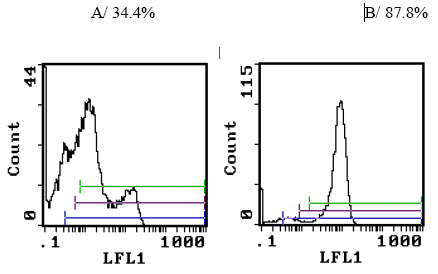Cd3e Hamster Monoclonal Antibody [Clone ID: 145-2C11]
Specifications
| Product Data | |
| Clone Name | 145-2C11 |
| Applications | FC, FN, IHC, IP, WB |
| Recommended Dilution | Western Blot. Immunoprecipitation. Functional Studies: This Clone 145-2C11 was specifically designed to trigger T cell activation. Flow Cytometry (See Protocols). |
| Reactivities | Mouse |
| Host | Hamster |
| Isotype | IgG |
| Clonality | Monoclonal |
| Immunogen | H-2Kb sp from Armenian Hamster Spleen. Fusion Partner: Murine myeloma cell line SP2/0. |
| Specificity | This anti-Mouse CD3e monoclonal antibody is specific for a 25 kDa protein component (e-T3) of the antigen specific T cell receptor on all Mouse strains tested. The epsilon-T3 protein has been shown to be non-covalently associated on the cell surface ab heterodimer of the CD3 associated complex. This monoclonal antibody reacts with all mature T cells and can both activate and inhibit T cell function (1). This fact identifies epsilon-T3 as a cell surface protein involved in the transduction of activation signals. All peripheral T cells express this determinant however B cells and bone marrow cells have proven to be negative. Although the expression of this particular epitope on peripheral T cells is uniformly high, staining of thymocytes reveals distinct subpopulations of cells differing in the level of expression of this marker. This antibody will prove useful in studying the role of various components of the TCR complex in T cell activation and development, and will allow for the development of an animal model in which to investigate the immunoregulatory effects of in vivo administration of anti-CD3 antibodies, an area of obvious clinical importance. Anti-CD3e is ideal for Flow Cytometry applications, particularly as a specific marker for tracking Mouse T cells. |
| Formulation | PBS containing 0.02% Sodium Azide as preservative. State: Purified State: Liquid purified IgG fraction. |
| Concentration | 1.0 mg/ml |
| Purification | Protein G Affinity Chromatography. |
| Database Link | |
| Background | T cell activation through the antigen receptor (TCR) involves the cytoplasmic tails of the CD3 subunits: CD3 gamma, CD3 delta, CD3 epsilon and CD3 zeta. These CD3 subunits are structurally related members of the immunoglobulins super family encoded by closely linked genes on human chromosome 11. The CD3 components have long cytoplasmic tails that associate with cytoplasmic signal transduction molecules. This association is mediated at least in part by a double tyrosine based motif present in a single copy in the CD3 subunits. CD3 may play a role in TCR induced growth arrest, cell survival and proliferation. The CD3 antigen is present on 68-82% of normal peripheral blood lymphocytes, 65-85% of thymocytes and Purkinje cells in the cerebellum. It is never expressed on B or NK cells. Decreased percentages of T lymphocytes may be observed in some autoimmune diseases. |
| Synonyms | T3/Leu-4 |
| Note | STRAIN DISTRIBUTION: Procedure: as above Antibody Concentration: 0.5 µg/10e6 cells Strains Tested: BALB/c, C57BL/6, C3H/He, AKR/J Positive: BALB/c, C57BL/6, C3H/He, AKR/J Protocol: FLOW CYTOMETRY ANALYSIS: 1. Prepare cell suspension in Media A. For cell preparations, deplete the red blood cell population with Lympholyte®-M cell separation medium. 2. Wash 2 times. 3. Resuspend the cells to a concentration 2x10e7 cells/ml in media A. Add 50 µl of this suspension to each tube (each tube will then contain 1x10e6 cells, representing one test). 4. To each tube add 1.0-0.5 µg of this antibody per 1x10e6 cells. 5. Vortex the tubes to ensure thorough mixing of antibody and cells. 6. Incubate the tubes for 30 minutes at 4°C. 7. Wash 2 times at 4°C. 8. Add 100 µl of secondary antibody (FITC Goat anti-Hamster Ig) at a 1/70 dilution. PLEASE NOTE: Do not use PE Goat a Hamster IgG as the secondary antibody. 9. Incubate tubes at 4°C for 30-60 minutes. (It is recommended that the tubes are protected from light since most fluorochromes are light sensitive). 10. Wash 2 times at 4°C in Media B. 11. Resuspend the cell pellet in 50 µl ice cold Media B. 12. Transfer to suitable tubes for flow cytometric analysis containing 15 µl of propidium iodide at 0.5 mg/ml in phosphate buffered saline. (This stains dead cells by intercalating DNA). MEDIA: A. Phosphate buffered saline (pH 7.2) + 5% normal serum of host species + sodium azide (100 µl of 2 M sodium azide in 100 mls). B. Phosphate buffered saline (pH 7.2) + 0.5% bovine serum albumin + sodium azide (100 µl of 2 M sodium azide in 100 mls). FLOW CYTOMETRIC ANALYSIS Donor: BALB/c Cell Concentration: 1x10e6 cells Antibody Concentration: 0.5 µg/10e6 cells Isotypic Control: Hamster IgG |
| Reference Data | |
Documents
| Product Manuals |
| FAQs |
| SDS |
{0} Product Review(s)
0 Product Review(s)
Submit review
Be the first one to submit a review
Product Citations
*Delivery time may vary from web posted schedule. Occasional delays may occur due to unforeseen
complexities in the preparation of your product. International customers may expect an additional 1-2 weeks
in shipping.






























































































































































































































































 Germany
Germany
 Japan
Japan
 United Kingdom
United Kingdom
 China
China



